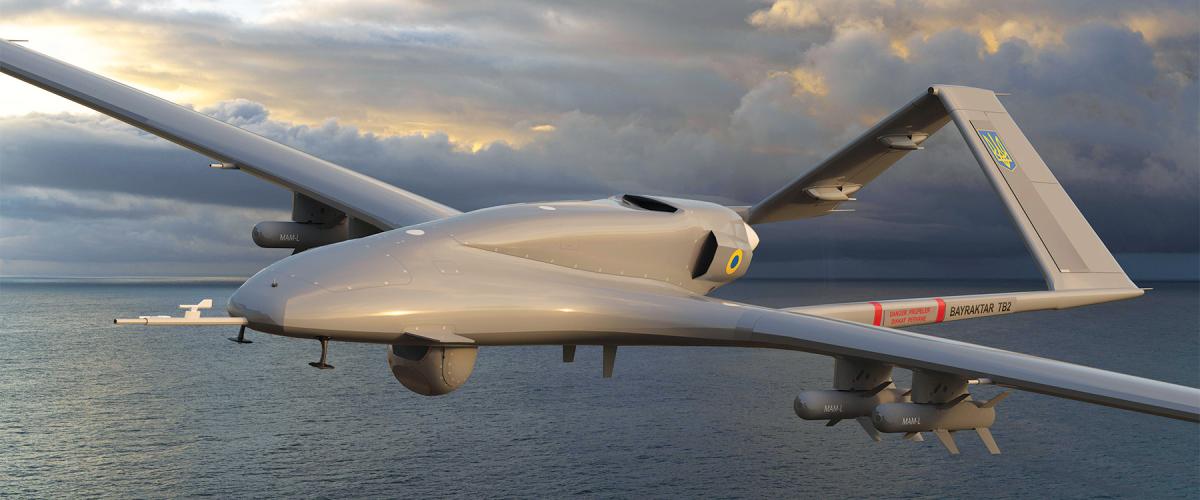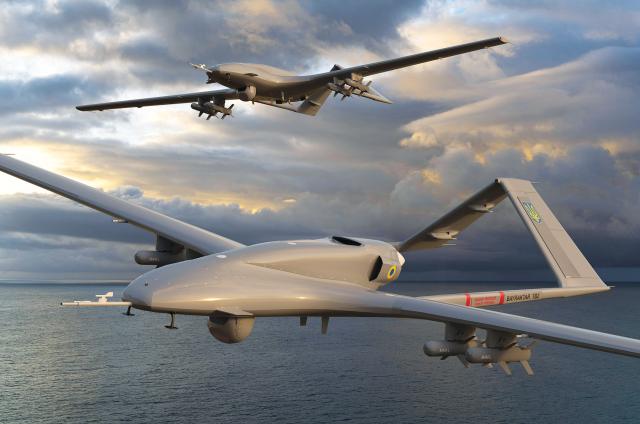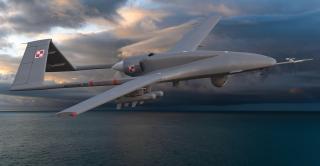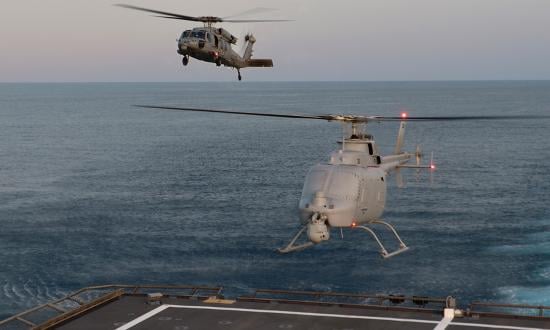Battles in Iraq, Syria, Nagorno-Karabakh, and Ukraine have given the world an appreciation for the potential of intelligent autonomous systems. If these wars have taught analysts anything, it is this: Uncrewed aircraft will saturate the battlefield and provide states and nonstate actors with air forces that degrade traditional measures of warfare such as troop numbers and matériel strength. As a result, enemies of the United States and its allies will leverage autonomous aircraft and other asymmetric weapons of war to conduct military missions.
Despite current Departments of Defense (DoD) and Homeland Security (DHS) efforts, the United States is far behind the curve in terms of what technology should be used to combat this asymmetric threat. The conventional plan—using ground-based technologies to counter uncrewed aircraft systems—is a mistake. Instead, the United States should adopt a defend-forward approach using technologies and procedures that anticipate instead of react.
The human and collateral risks of interdiction through kinetic means and radio-frequency jamming, which can be less effective and more disruptive to friendly installations, could be mitigated with known techniques in the cyber domain. Further, these cyber techniques are not bound to terrestrial systems but are mobile—even for use on small aerial platforms. They suggest a future in which autonomous fighters engage uncrewed aerial threats digitally. Using cyberattacks to interdict airborne enemy drones, security forces can increase their capability and capacity to defend.
surface-to-air missile equipment despite the BUK having a maximum effective range more than four times greater than that of the TB2. Alamy
What Is Wrong with What We Have?
For commercial drones, the current counter-uncrewed aerial system (C-UAS) methods primarily operate through broadband jamming, which suffers from disadvantages such as high power consumption, mobility issues, and costs, as well as technical and legal limitations. Other C-UAS options include kinetic aerial interdiction such as nets, projectiles, and battering-ram drones, each subject to limitations that make broadband jamming an attractive option.1
Against larger drones, the principal countermeasures are integrated air-defense systems that include surface-to-air missiles and antiair artillery. These ground-based systems have inherent technical limitations, as projectiles have rate-of-fire and accuracy limitations, and electromagnetic waves must overcome the interference from surrounding information systems. The potential for physical and electronic collateral damage cannot be ignored.
These technical limitations have never been more evident than in the Ukraine war, when a column of Russian BUK surface-to-air missiles (SAMs) was destroyed by a single Ukrainian TB2 drone. Despite the maximum effective altitude of the BUK missile being 25 km against the TB2’s 5.5 km, the TB2 was still able to destroy $50 million of Russian SAM equipment.2 Such events raise the question of how the United States can strengthen its C-UAS posture.
Why Not Kinetic Fighters?
If a primary issue with the current C-UAS framework is that it overemphasizes bulky, terrestrial systems, the next logical solution might be to increase mobility by attaching current systems to other aircraft. However, just as with the terrestrial versions, radio-frequency jamming and physical projectiles still pose a host of problems for the surrounding environment.
Small aerial kinetic effector drones in groups 1 and 2 (which weigh up to 20 and 55 pounds, respectively) must overcome flight dynamics that slow the defender device and delay its response time. When designers add a projectile payload, net, or explosive, they must stabilize the mounting device to control the direction of fire, which creates size, weight, and power (SWaP) considerations. This makes them slow and increases the difficulty of maneuver, and they have only a limited number of rounds.3
Non-projectile aerial systems such as Anduril Industries’ Anvil employ a battering ram, which has shown some effectiveness in field experiments.4 However, the Anvil uses a computer-vision algorithm to track its targets, making reliable, accurate predictions of the behavior and movement of an autonomous target improbable outside the lab.5 The main problems with such systems are the precision needed to physically hit the target with a battering ram, the collision damage to a defensive drone, and the one-to-one symmetric nature of defense and offense. The other alternative—nets—limit collateral damage but are more difficult to maneuver. In short, aerial kinetic defenders could struggle to achieve a kill and pose serious risks to surrounding infrastructure and personnel.
Nonkinetics Are the Perfect Blend
Cyber interdiction of uncrewed aircraft systems offers an alternative—a targeted countermeasure that mitigates not only the physical collateral damage from projectile fallout, but also the damage to information and communication systems that broadband jamming inflicts, i.e. “friendly fire jamming.”6 Instead, cyber interdiction targets specific devices or even groups/swarms of devices, but without the directional or computer-vision requirements typical of kinetic C-UASs. As a further benefit, cyber payloads that exploit protocol vulnerabilities in the transmission of digital signals allow designers to reduce the SWaP requirements of the physical hardware systems.7 For example, a defensive drone operating with a Raspberry Pi (or similar) micro-PC, a software-defined radio, and a 5-volt power source can conduct a wide variety of cyberattacks on adversarial drones.
In 2014, well-known hacker Samy Kankar hacked a Parrot ARDrone 2.0 by developing his own software to deauthenticate the legitimate user and take control of the target device.8 This experiment has been repeated for a variety of drone targets, yet DoD and DHS have not taken advantage of the low-SWaP technology potential. When flown on board friendly uncrewed aerial devices, these cyber payloads provide even longer range and can act as aerial patrols across larger protected zones than terrestrial systems can reach.
While the two federal agencies have the capability to solve the technology problem, the legal limitations associated with electronic warfare and cyber interdiction could prove more difficult. All C-UASs are subject to various legal restrictions depending on their techniques, but the relative gain in reduced collateral damage and risk to humans should make cyber solutions more attractive than projectiles from a legal standpoint. Systems that use cyber interdiction are subject to the limitations contained within the Pen Register Act—which governs the monitoring of internet communications—and other authorities granted to government entities under the U.S. Code (e.g., Titles 10, 18, and 50).9 These limitations pose a difficulty for cyber interdiction of intelligent autonomous systems, but one that Congress and the executive branch have the opportunity to work together to overcome.
Mitigation of uncrewed aerial threats is a challenge that can be met only with concerted effort and innovative planning. Yet, when strategically selected, such solutions can provide far better protections and fewer negative second- and third-order effects than current terrestrial systems. Mobile cyber interdiction systems, especially aerial ones, could create a future in which autonomous aircraft destroy or disable uncrewed aerial threats with bits and bytes, not bullets.
1. Maria Goodrich, “Drone Catcher: ‘Robotic Falcon’ Can Capture, Retrieve Renegade Drones,” Michigan Tech News, 7 January 2016; Scott Brooks et al., Counter Unmanned Aircraft Systems Market Survey (UUR), Sandia Report (Albuquerque, NM: Sandia National Laboratories, 1 March 2019); “Anduril—Anvil,” Anduril Defense Technology, 2021; Arthur Holland Michel, Counter-Drone Systems, 2nd ed. (Annandale-on-Hudson, NY: Center for the Study of the Drone, Bard College, December 2019).
2. “Buk-M2E Air Defence Missile System,” Army Technology (blog), 1 May 2014; Baykar Technologies, “Bayraktar TB-2,” Baykar Defence; and Billy Perrigo, “Ukraine’s Secret Weapon Against Russia: Turkish Drones,” Time, 1 March 2022.
3. Goodrich, “Drone Catcher.”
4. “Anduril—Anvil.”
5. Christian Thiessen, “Redesigning the Counter Unmanned Systems Architecture” (master’s thesis, Monterey, CA: Naval Postgraduate School, 2022).
6. Christian Thiessen, Douglas Van Bossuyt, and Britta Hale, “Reducing Asymmetry in Countering Unmanned Aerial Systems,” in Acquisition Research: Creating Synergy for Informed Change, vol. 19 (Monterey, CA: Naval Postgraduate School, 2022), 273–87.
7. Chee Hoe Lee, Christian Thiessen, Douglas Van Bossuyt, and Britta Hale, “A Systems Analysis of Energy Usage and Effectiveness of a Counter-Unmanned Aerial System Using a Cyber-Attack Approach,” MDPI Journal Drones, 2022.
8. Samy Kankar, “SkyJack: Autonomous Drone Hacking,” Samy Kankar blog, 2 December 2013.
9. “Pen Registers and Trap and Trace Devices,” Pub. L. No. 100–690, Title 18, Ch. 206 (1988).








